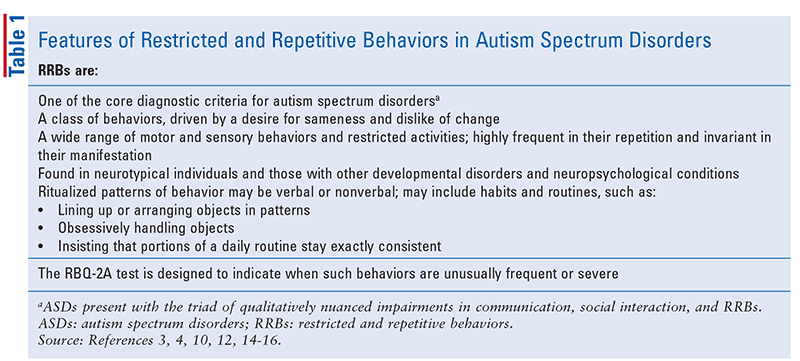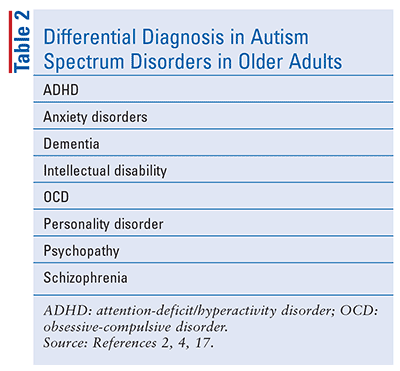US Pharm. 2019;44(8)8-10.
Together with an understanding of gerontology and disease-specific conditions in the aging adult, proper geriatric medical care requires an awareness of complexity and a focus on function. Compared with the majority of middle-aged individuals, older patients have many comorbid conditions, are taking multiple medications, and suffer secondary problems regarding physical, functional, psychological, and social health. Fillet and colleagues indicate that critical to geriatric medical care is an appreciation of complexity, with an emphasis on multidisciplinary, coordinated care management.1 It is with these concepts as a foundation that the issue of autism spectrum disorders (ASDs) in older adults is raised here to heighten pharmacists’ awareness of ASDs as possible underlying, undiagnosed conditions that may be affecting their patients’ health and to identify resources for further reading.
ASDs can easily be missed in older adults who present clinically with comorbid psychiatric disorders. Raising awareness among healthcare professionals who work with this special population regarding the possibility of ASDs in older patients is a necessary initiative while research on this issue continues.2 ASDs, initially described by Kanner in the early 1940s, consist of a group of neurodevelopmental disorders that are complex in nature and encompass autistic disorder, Asperger syndrome, and pervasive developmental disorder, unspecified.3,4
These conditions characteristically present with qualitatively nuanced impairments in social and communicative behaviors (e.g., deficits in nonverbal communicative behaviors used for social interaction, deficits in developing and maintaining relationships) and restricted and repetitive patterns of behavior (TABLE 1). The limitation and impairment of everyday function results from the manifestation of symptoms in conjunction with one another. The prevalence of ASDs is estimated to be 0.6%–0.7%, with a diagnosis commonly made in childhood, and typical onset prior to age 3 years.5,6
It is highly likely ASDs are underdiagnosed in older people.2 One important factor is the paucity of literature on the subject, suggesting a lack of awareness of ASDs among mental health professionals working with older adults.2 Failure to diagnose an ASD may potentially lead to iatrogenic problems and increased healthcare costs secondary to excessive use of management modalities (e.g., protocol-based psychotherapy or electroconvulsive therapy) for mental health problems that are due to ASDs.7 Conventional medication therapy may not be efficacious in treating what is actually underlying the patient’s clinical presentation and may complicate polypharmacy, particularly in frail elderly adults. It is more likely, however, that resolution may be achieved by simple psychosocial interventions, such as creating a more predictable environment for the older adult with an ASD.2 Key to creating an individual management plan is a comprehensive understanding of a person’s level of functioning, whether physical and other mental health problems are present, and whether the patient exhibits challenging behaviors.4
ASD is a relatively recent diagnosis. Historically, the reasons older adults with ASDs were not diagnosed in childhood are, first, that the diagnosis did not exist when these adults were children.4
• In 1980, autism first appeared in the Diagnostic and Statistical Manual of Mental Disorders (DSM)-III
• In 1992, autism and Asperger syndrome first appeared in the World Health Organization’s International Classification of Diseases
• In 1998, Asperger syndrome first appeared in DSM-IV
• Knowledge of the persistence of these disorders after childhood was limited
Secondly, validated screening and diagnostic ASD instruments for the assessment of older adults are not available.4 Lastly, psychiatric comorbidity, which is very common, may mask an ASD.8 It has been noted, possibly owing to the facts above, that referral to a geriatric psychiatrist for a suspected ASD is not common.7
Risk of Depression and Anxiety
Much flexibility is required to adequately cope with change, and since patients with ASDs typically have an inflexible disposition, great difficulty dealing with change emerges. The changes one experiences in the course of life can provoke major behavioral disturbances and psychiatric disorders, such as depression or anxiety; comorbid psychiatric disorders may mask the not-yet-identified ASD pathology.9
Need for Screening and Differential Diagnosis
Older patients require adequate screening for the proper diagnosis of ASDs; a diagnosis may offer the patient, family, and caregivers (including staff in residential care and nursing-home facilities) a bit of relief in receiving an explanation for current problems in addition to perspective on certain (e.g., “odd”) lifelong behaviors. As noted above, failure to diagnose an ASD may lead to iatrogenic problems.
Since autistic features can be disguised by comorbid psychiatric disorders, pharmacists are encouraged to become familiar with the differential diagnosis of ASD in older adults (TABLE 2).9 Specific differentiating parameters of these disorders, as compared with features of ASDs, can be reviewed in Table 2 in Reference 2. Additionally, although 30% of individuals with ASD function within the normal range of intelligence (IQ >85), compensation by a person with normal or high intelligence can also disguise autistic features.2
Autism Self-Assessment Screening Tool
Engaging in a thorough history with the patient regarding the specific behaviors of ASDs remains the most important diagnostic tool, as long as it is corroborated and supplemented by a close family member, significant individuals, or a caregiver with knowledge of the patient for at least 10 years.2 However, in diagnosing an older individual, it can be more difficult to obtain relevant information from surviving family members; furthermore, cognitive impairment may compromise the reliability of the information provided.
As described in the Journal of Autism and Developmental Disorders, a new test may be one of the first effective self-assessments for a core symptom of autism in adults.10 Recently, researchers at the Wales Autism Research Centre at Cardiff University in the United Kingdom have developed a test in which individuals can report their own behaviors.10 The Adult Repetitive Behavior Questionnaire (RBQ-2) measures the extent to which adults are affected by restricted and repetitive behaviors (RRBs). As discussed above, RRBs comprise one of the core symptoms of autism, along with social and communication challenges.
The RBQ-2A was developed to describe a profile of RRBs and indicate when such behaviors are unusually frequent or severe; it does not measure social communicative behaviors and thus is not suitable as a stand-alone diagnostic tool for ASDs, since including both domains is necessary and essential for a diagnosis.10 Important limitations to consider include: 1) although samples in both studies include a fairly wide range of ages (i.e., 18 to 50 years), these findings cannot be generalized to older adults; 2) the RBQ-2A was adapted from a measure for children and may be missing certain items that are applicable only to adults.10 Studies presented by these researchers represent an important new contribution in the development of an adult self-report measure of RRBs that can be used in both patients with ASDs and in neurotypical populations.10
Role of the Pharmacist
Autistic features can be disguised by comorbid psychiatric disorders, and failure to diagnose ASDs may potentially lead to iatrogenic problems. Since an ASD is a lifelong condition, raising awareness of differential-diagnosis nuances in older adults may help avoid treatment of patients for “refractory” depression or anxiety and more appropriately allow for the provision of a necessary and more predictable environment for the older adult with an ASD. A new self-assessment screening tool holds promise in identifying RRBs in adults. Sound geriatic care requires an appreciation of complexity, a focus on function, and an emphasis on multidisciplinary, coordinated care management.
REFERENCES
1. Fillit HM, Rockwood K, Woodhouse K. Introduction: aging, frailty, and geriatric medicine. In: Fillit HM, Rockwood K, Woodhouse K, eds. Brocklehurst’s Textbook of Geriatric Medicine and Gerontology. 7th ed. Philadelphia, PA: Saunders Elsevier; 2010:1-17.
2. van Niekerk EH, Groen W, Vissers CT, et al. Diagnosing autism spectrum disorders in elderly people. Int Psychogeriatr. 2011;23(5):700-710.
3. Kanner L. Autistic disturbances of affective contact. Nerv Child. 1943;2:217-250.
4. O’Regan D, Tobiansky R. Diagnosing autism spectrum disorders in older adults. J Geriatr Med. Midlife and Beyond; October 2014;33:46-51.
5. Fombonne E. Epidemiology of pervasive developmental disorders. Pediatr Res. 2009;65:591-598.
6. 2019 ICD-10-CM Diagnosis Code F84.0. Autistic disorder. www.icd10data. com/ICD10CM/Codes/F01-F99/F80-F89/F84-/F84.0.
7. James IA, Mukaetova-Ladinska E, Reichelt FK, et al. Diagnosing Asperger syndrome in the elderly: a series of case presentations. Int J Geriatr Psychiatry. 2006;21:951-960.
8. Gillberg C, Billstedt E. Autism and Asperger syndrome: coexistence with other clinical disorders. Acta Psychiatr Scand. 2000;102:321-330.
9. Kan CC, Buitelaar JK, van der Gaag RJ. Autism spectrum disorders in adults. Ned Tijdschr Geneeskd. 2008;152:1365-1369.
10. Barrett SL, Uljarević M, Baker EK, et al. The Adult Repetitive Behaviours Questionnaire-2 (RBQ-2A): a self-report measure of restricted and repetitive behaviours. J Autism Dev Disord. 2015;45(11):3680-3692.
11. Autism Research Centre, School of Clinical Medicine in the Department of Psychiatry, University of Cambridge, England. Downloadable tests. www.autismresearchcentre.com/arc_tests. Accessed July 19, 2019.
12. American Psychiatric Association. Diagnostic and Statistical Manual of Mental Disorders, 5th ed. Washington, DC: American Psychiatric Association. 2013.
13. National Institute for Health and Care Excellence. Updated August 2016. Autism spectrum disorder in adults: diagnosis and management. www.nice.org.uk/guidance/cg142. Accessed July 19, 2019.
14. World Health Organization. The ICD-10 classification of mental and behavioral disorders. (1993). Geneva: World Health Organization.
15. Langen M, Durston S, Kas MJH, et al. The neurobiology of repetitive behavior: …and men. Neurosci Biobehav Rev. 2011;35(3):356-365.
16. Leekam SR, Prior M, Uljarević M. Restricted and repetitive behaviors in autism spectrum disorders: a review of research in the last decade. Psychol Bull. 2011;137(4):562-593.
17. Hansman-Wijnands MA, Hummelen JW. Differential diagnosis of psychopathy and autism spectrum disorders in adults: empathic deficit as a core symptom. Tijdschr Psychiatr. 2006;48:627-636.
To comment on this article, contact rdavidson@uspharmacist.com.







